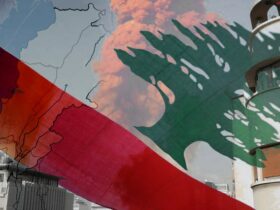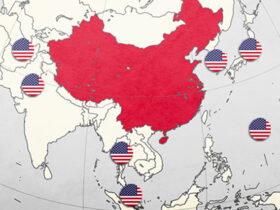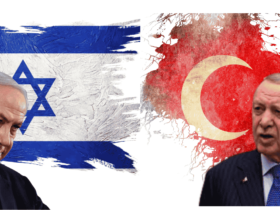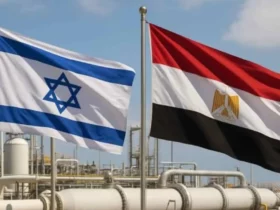The risks of the first water war in Africa seem high as Addis Ababa shows it is not ready to compromise on the construction of a dam which could end up having disastrous effects on Egypt’s water economy.
An article by UWI’s Islam Farag on the issue of Grand Ethiopian Renaissance Dam has caused a storm of outrage among Ethiopian internet users. However, in addition to emotional arguments, we require rational ones. In this article, we will assess how legitimate the positions of each party to the dispute are and how likely a forceful solution to the problem is.
The Ethiopian Dam: a game bigger than generating electricity
The Grand Ethiopian Renaissance Dam (GERD) is a project Ethiopia’s current leadership considers key to the country’s economic development. They believed that by blocking the Blue Nile, Ethiopia will be able to build the largest hydroelectric power plant in Africa and fully meet not only its own electricity needs, but also have enough to sell abroad. At the same time, as a result of the creation of the giant reservoir, the water supply of Egypt and Sudan and the agricultural production of these countries will be threatened.
Naturally, Egyptian leadership strongly opposes the project, especially given the fact that it is being implemented without Cairo’s approval. For Egypt, the building of the dam is a matter of life and death. At the same time, all attempts to find a compromise have failed. The US’ attempt to act as a mediator in early 2020 was also unsuccessful, as Ethiopia refused to sign an agreement with the US Treasury and the World Bank.
At the same time, Ethiopian Prime Minister Abi Ahmed’ stated that the reservoir for the GERD will already begin to be filled this year during the rainy season (July 2020). The country’s leadership is demonstrating that it is ready for unilateral action, not taking into account the interests of countries whose existence largely depends on the Nile River, and Egypt first of all.
Aside from electricity, there is another factor important to the Ethiopian side – food security. In Ethiopia’s view, Addis Ababa’s lack of control over the upper Nile was allegedly the reason for the country’s food problems. Ethiopian analyst Mahemud Tekuya argues that: “This heavy reliance on traditional farming left many Ethiopians vulnerable to hunger, and a series of droughts have long kept millions of families ‘on the ragged edge of starvation.’ From 1983 to 1985, more than one million Ethiopians died prematurely from malnutrition.” (http://addisstandard.com/op-ed-nile-dispute-taming-the-elephant-in-the-room/).
A similar sentiment was expressed by another Ethiopian analyst, Mekdelawit Messay Deribe, who argues that “It is out of this necessity and the need to eradicate the poverty that the Grand Ethiopian Renaissance Dam is conceived and being implemented”.
While this is a compelling argument, the history of Ethiopia in the second half of the 20th century and the 21st century raises certain doubts that the central problem is the unequal use of the Nile’s water, rather than, for instance, ineffective Ethiopian leadership, tribal strife and the fact that country is in a state of permanent civil war.
The same authors argue that the construction of the dam would allow Ethiopia to “modernize” and grant people access to electricity. However, this argument is refuted by the almost total absence of a power grid in the country. Electricity will only be a means of enriching the Ethiopian elites who will mostly sell it to other countries.
International law
Currently, international law is on Egypt’s side. Let’s remember that according to the Anglo-Egyptian contract of 1929, Egypt has received the veto right in regard to the construction of anything on the river Nile or its inflows. The Ethiopians have tried to negate and belittle this treaty in every way possible, given that it was signed during a period of colonialism and Ethiopia was not a party to the agreement. Ethiopia also did not sign another agreement, the Egyptian-Sudan Treaty of 1959, according to which Egypt received 55.5 billion cubic meters (BCM) (or 66%) of the rivers total 84 BCM water flow, while Sudan received 18.5 BCM.
In 1902, Ethiopia signed an agreement with the British-controlled Sudan under which Addis Ababa was obliged “not to construct or allow to be constructed any work across the Blue Nile, Lake Tana, or the Sobat, which would arrest the flow of their waters into the Nile”.
There have been no new agreements to replace these treaties signed during colonial times.
In 2015, Egypt, Sudan, and Ethiopia signed the Declaration of Principles, which recognized Ethiopia’s right to build a dam (GERM). However, there is no full-fledged international treaty that is unambiguously interpreted by all the parties to the conflict and in which all the countries of the Nile Basin participated.
According to Mahemud Tekuya, the core of the current problems are the colonial era treaties. This thesis is particularly popular among Ethopian leadership and their supporters.
In this perspective, Egypt is painted as having inherited British strategies while monopolizing control of the Nile. However, this is not exactly the case. Egypt believes the Nile is an international river to which the rules of international rivers must be applied. The problem is that Egypt would like to keep the certain volume of water resources coming from the Nile, meanwhile, Ethiopia refuses to provide such guarantees or sign any agreements, instead resorting to unilateral actions.
Mekdelawit Messay Deribe says that “Living as if Egypt is the only country whose lifeline is tied to the Nile and not the others is a gross misrepresentation of facts which serves no purpose for the collective gain of the basin”.
While this might be the case, this hardly vindicates the Ethiopian’s stance given that Addis Ababa’s unilateral actions indicate that they too see the Nile as their sole possession.
Water wars and military options
Egypt has repeatedly suggested that Ethiopia use alternative means to produce electricity on a scale comparable to that of GERD without blocking the Nile. Cairo is already offering such solutions to other countries in the region. Ethiopia, however, refuses. Under such circumstances, Egypt, as Islam Farag notes, is beginning to believe that:
“Ethiopia aims to monopolize the waters of the Nile in order to turn it into a commodity, and thus force others to buy it. This is extremely dangerous politically and socially, especially for Egypt, which has no other water sources than this river and has a population of more than 100 million”.
Water is Egypt’s most valuable resource. Selling water would not only make the country dependent on Ethiopia, it could also provide a source of permanent income for the poor country if Egypt accepted the terms.
However, Ethiopia’s game of escalating, renouncing agreements and unilaterally constructing hydroelectric power plants is only making things worse. Egypt has been left with little time to try to resolve the situation on international platforms, including through the UN. Addis Ababa has de facto left Cairo with no other choice than to take a military option.
Moreover, if Ethiopia is able to build a dam with impunity that threatens to cut off Egypt’s water sources, this could set off a chain reaction. Other countries in the region might follow suit, trying to blackmail each other and their neighbors by limiting their access to fresh water. In the African context, this could lead to numerous wars over water resources.
As Al Jazeera reported, investors from China and the Ugandan authorities intend to conclude an agreement to build a dam on the Nile River. Currently, the $1.4 billion White Nile hydropower project is still under discussion.
This is not the first time Egypt is looking into the possibility of solving the GERD problem by force. In 2012, the US private-security firm Stratfor revealed that in 2010, Egypt discussed taking military action in cooperation with Sudan against Ethiopia to protect their stake in the Nile River. These plans included the Ethiopian dam being detonated by Egyptian commandos operating from a base in Sudan or being destroyed in an aerial assault.
In 2013, Egyptian leader Mohammed Mursi said that Cairo did not want war, but the water supply could not be compromised. He declared that “all options are open” to defend it.
Thus, regardless of the change of power in Egypt, the military solution to the Ethiopian dam has always been Egypt’s arsenal. It is unlikely that Fattah el-Sisi, a tough leader and military man, would be less inclined to take this path than previous leaders.
In addition, international perception of Ethiopia as an unstable country whose control of the Nile could prove dangerous further justifies the possibility of a military option. Just last year, the death of the Chief of Staff of the Ethiopian army Se’are Mekonnen caused a stir throughout the country. A year earlier, thousands of soldiers had come to the Prime Minister’s residence demanding a salary increase. According to Abiy Ahmed, their actual goal was to kill him. In June 2018, during the riots, a grenade was thrown at the Prime Minister. The Ethiopian army has proven that it is not a unified force which is fully under the control of its command.
The war scenario
Back in March, Ethiopia’s Chief of Staff, Lieutenant General Adam Mohamed, said that the army is ready to resist any attack on the Great Renaissance Dam on the Nile.
However, if we compare Egypt’s and Ethiopia’s military power, things do not look good for the Ethiopian side.
In the 2020 Index of Military Strength by Global Firepower Egypt was ranked 9th, just after the UK. Egypt has the most powerful military in Africa. Ethiopia, meanwhile, ranked 60th.
The Stockholm International Peace Research Institute in 2019 noted that Egypt was one of the 5 largest arms importers in the world.
Over the last 5 years, Egypt has been actively rearming its military, 5.1% of the world’s weapons imports coming from the country. The Egyptian Air Force’s MiG-21s, F-7 Skybolts, F-4 Phantoms, Dassault Mirage Vs are relatively old, but some are heavily modernized, and undoubtedly capable of bombing a dam. In 2013, Cairo ordered 40 MIG-29M ‘4+ multirole aircraft from Russia alongside S-300V4 long range surface to air missile batteries.
Of course, an airfield in Sudan would likely be required for an airstrike, otherwise Egyptian planes could reach Ethiopia from Egypt with extended fuel tanks mounted on fighter jets.
There have also been reports that Egyptian Scud-B ballistic missiles are capable of reaching Ethiopian territory. As the North Korean experience shows, Egyptian vintage Romeo class diesel-electric attack submarines can be modified to carry ballistic missiles.
We cannot also not rule out the use of proxy forces in blowing up the dam or destabilizing the country in order to stop the commissioning of the GERD. It is worth recalling Egypt’s links with South Sudan and Eritrea (and the unconfirmed reports about an Egyptian base in the country). In the event of a crisis, Eritrea would likely not help prevent Egyptian planes from bombing Ethiopia.
As for the Ethiopian armed forces, their deplorable condition demonstrates the failure of the country’s ongoing wars with tiny Eritrea. Much of the air defense of the country is made up of Soviet installations from the Vietnam War.
At the end of last year, the newest Russian manufactured Pantsir S1 air defense combat vehicles were spotted in the country. However, these are systems designed to provide close cover for civilian and military facilities and are not effective against all offensive weapons. In addition, these systems require well-trained personnel. Presuming that there are no such personnel among the Ethiopian troops, Cairo has a window of opportunity to strike.
Ethiopia has 36 relatively modern fighters, 18 Su-27 and 18 MiG-23, but their technical condition is in question. Thus, the rapid air operation against the Ethiopian dam certainly seems possible, although risky. Regardless, in the event of a remote conflict, Ethiopia would not be able to respond to the Egyptians with a counterstrike: the only thing it will be able to do is ask for support from the international community.
Don’t corner Egypt
Is such an operation politically possible? The Ethiopian side is relying on the protection of the international community against a possible attack by Egypt. However, neither the international community nor international law has shielded other countries from far stronger attacks in recent years. A typical example is what is happening in Libya.
The world is now builty around the principle of the survival of the fittest. Power is not only a military matter, it also comes in the form of the support of allies and the development of mutually dependent relationships.
Egypt is now such a partner for the US and Russia, Saudi Arabia, the UAE and France. The latter three of these countries are cooperating with Cairo in the Libyan conflict and are unlikely to oppose it; Ethiopia is of little importance to all of them. US President Donald Trump is pushing away from the US’ former role as world’s police, and is unlikely to defend Ethiopia. Moreover, it was Ethiopia that rejected his proposal, which means that according to the logic of the American president, if Ethiopia is attacked, it’s essentially their own fault.
The risks of an attack on Ethiopia are not so great for Egypt as the loss of water, which would completely stop life in the country and likely destabilize it forever. Given the circumstances, it is clear that Ethiopian leadership is acting rashly by accelerating the filling of the dam, an action which further provokes Egypt to take military action.
Egypt can save itself by destroying the dam, but doing so threatens possible losses among pilots and a certain deterioration of international positions. Therefore, the best outcome would be an agreement between Cairo and Addis Ababa. Perhaps mediation should be sought not from the US or the World Bank, but from the African Union, China or Russia.

















Leave a Reply